In September 2020 I gave a presentation for Johannes Kleiner’s Mathematical Consciousness Science series. The recording turned out a bit quiet; here are my slides with brief commentary (from an April 2022 perspective).

Beautiful philosophy takes the messy and complicated, and leaves it clean, simple, and obvious.
One way to frame this is that philosophy is the process of identifying, debugging, and fixing confusion. This can be tricky, since confusion is implicitly high-dimensional: there are many many different ways to be wrong, and few (or perhaps just one) way to be right.
Confusion is especially tricky when we’re dealing with metaphysics, the basic structure of reality, since these differences condition the words we use to describe our differences. When our words mean different things, it’s hard to hold a productive conversation. This factor is very much in play when discussing consciousness.
The approach I’ve found works best here is to put energy into distilling philosophical confusion into binary yes/no scenarios we can all agree on. To find X’s such that “either we live in a universe where X is exactly true, or we live in a universe where X is false.” (This heuristic is partly inspired by Wheeler’s brilliant “it from bit” frame, from which I’ve also shamelessly stolen my title.) The goal is to redirect energy away from dissipative high-dimensional confusion and channel it toward evaluating definite scenarios; binary questions where it’s clear some fact must be either true or not true, with no muddled middle.
I really like this approach for dealing with confusion, since each such “fork-in-the-road question” cuts our unstructured blob of confusion in half, and once we have structure we can apply various clever heuristics to narrow down our search space.“Divide and conquer” is powerful.
In this frame, perhaps “solving consciousness” involves finding ~30 crucial binary questions about how things work — one billion possible universes we might live in — then through inference and experiment determining which one we do live in. I don’t know the real number, but I think it’s discrete and (surprisingly) finite.
Today, I have ten binary questions about consciousness. Implicitly, this describes 2^10=1024* possible universes we might live in, each with slightly different metaphysics. I have intuitions on what the answers are — but mostly I’d like to just focus on the questions themselves.
*this is an upper bound, since the validity of some binary questions is conditional on answers to others.
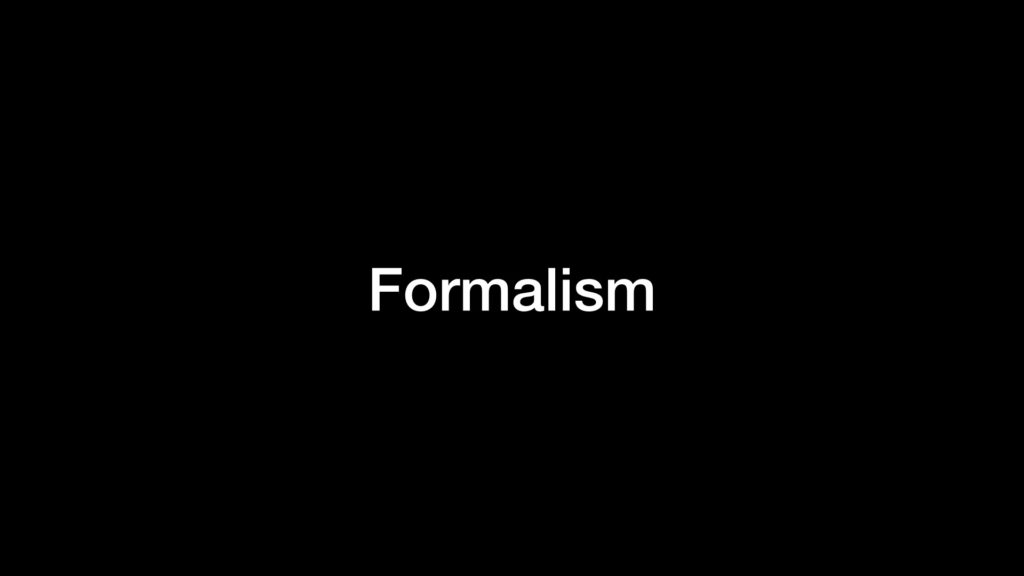
Formalism is the idea that mathematics is the right language for describing something; creating a formalism for something is an attempt at making its structure explicit. There’s what I would call ‘weak formalism’ — the idea that math is instrumentally useful for working with a topic — and ‘strong formalism’ — the idea that there’s some sort of exact formal structure latent in reality and our job is to discover and describe it.
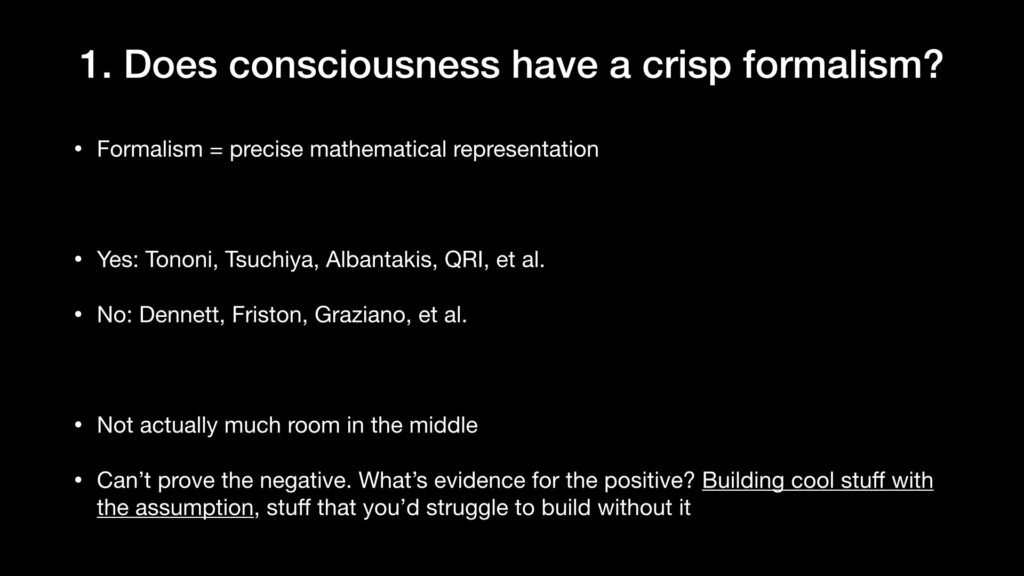
If consciousness has a crisp mathematical structure, our job as consciousness researchers is to find it. If consciousness does not have a crisp mathematical structure, our job as consciousness researchers is to dissolve whatever confusion we have around the word “consciousness” that makes us look for an answer. This is a really important question that leads in two very different directions.
Loosely speaking, the Formalism torch is carried by Tononi and the IIT research ecosystem surrounding him, by many physicists, and by a few outsiders (such as myself and QRI). Formalism tends to be an explicitly held view; the ‘unexamined cultural default’ view is that formalism is not true. Most neuroscientists, most philosophers, and most AI/ML researchers are tacitly against the idea of ‘strong formalism’ in regards to consciousness.
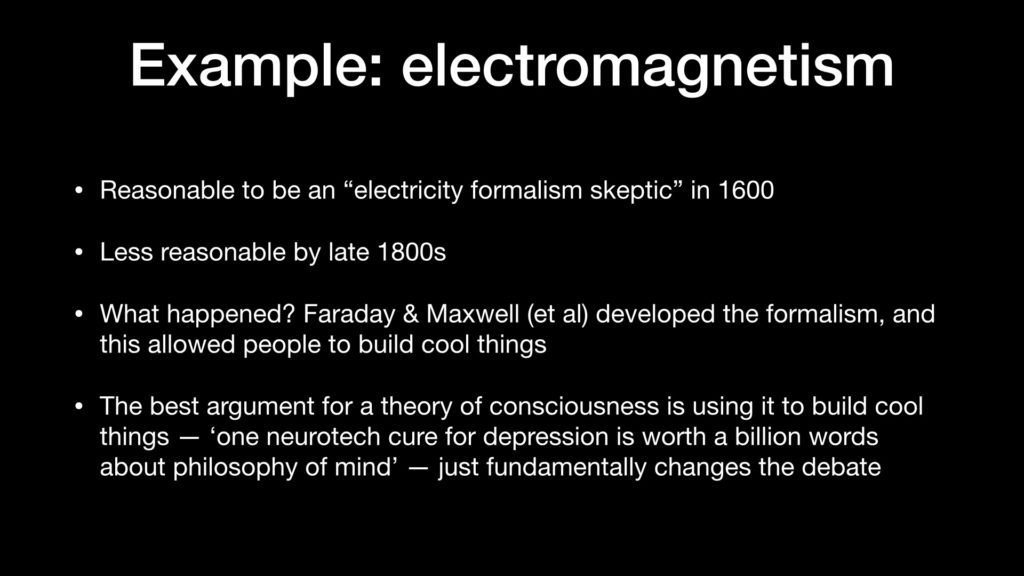
The history of science is full of examples of discovering crisp formalisms. Electricity is a great example; Faraday observed some patterns, and Maxwell generalized these into the laws of electrodynamics. These laws are exactly true across the universe, and power the computer you’re using to read these words. Their ‘realness’ is hard to dispute. The history of science is also full of examples where people thought there was something fundamental and exact to discover, but there wasn’t. Élan vital and the four humors are examples where the correct move was to dissolve confusion rather than dig into reality to find an exact mathematical structure.
This question of “is consciousness a natural kind” — is it a fundamental and intrinsic part of reality? — is really central. The tricky thing here is it’s impossible to prove a negative; my sense is there’s been an underinvestment in the sorts of systematic thinking that could discover the mathematical structure of consciousness, so it’s valuable to assume it has one and generate some hypotheses as to what this structure might be. And then see if we can turn these hypotheses into novel predictions (and ultimately useful technology). If we succeed, we create a new science; if we fail, we were still right to try. Hopefully we had fun.
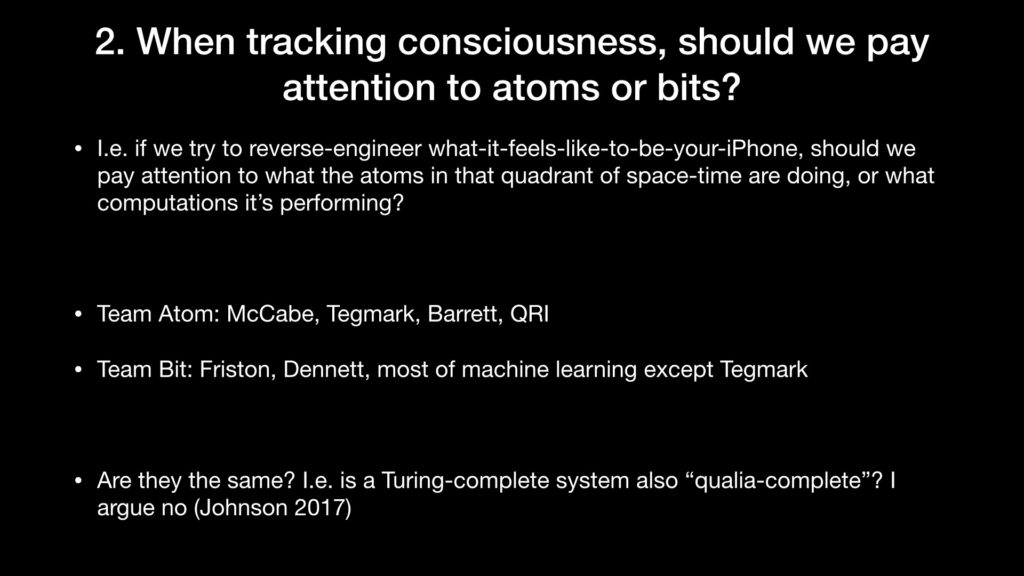
Popular discussions of machine consciousness assume that software can be conscious. They assume that bits are the natural substrate of consciousness: shuffle bits in the right way, and you get something that has subjective experience. The best work on this (in my biased view) comes from, or may arise from, the Markov blanket / world-modeling frame; e.g. Friston, Safron.
The alternative to looking at bits is to look at atoms instead. I discuss this view in Against Functionalism, leaning heavily on Aaronson 2014 and McCabe 2004. Roughly speaking, “team bits” tends to assume consciousness isn’t an exact ‘thing’ but a process; “team atoms” tends to lean formalist.
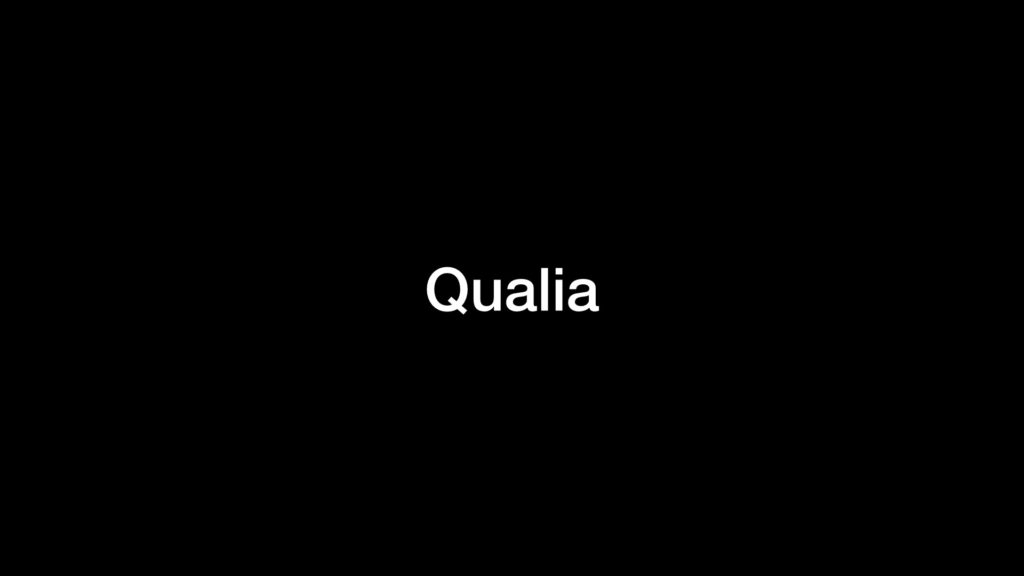
Much of the daily work of consciousness research within the formalism paradigm deals with trying to discover the natural kinds of qualia. E.g., the phenomenology of a cat is a complex bundle of simpler things. What are these simpler things? What are the atomic pieces of phenomenology, which get put together to make more complex experiences? What are the best mathematical tools for modeling the relationships between these atomic components?
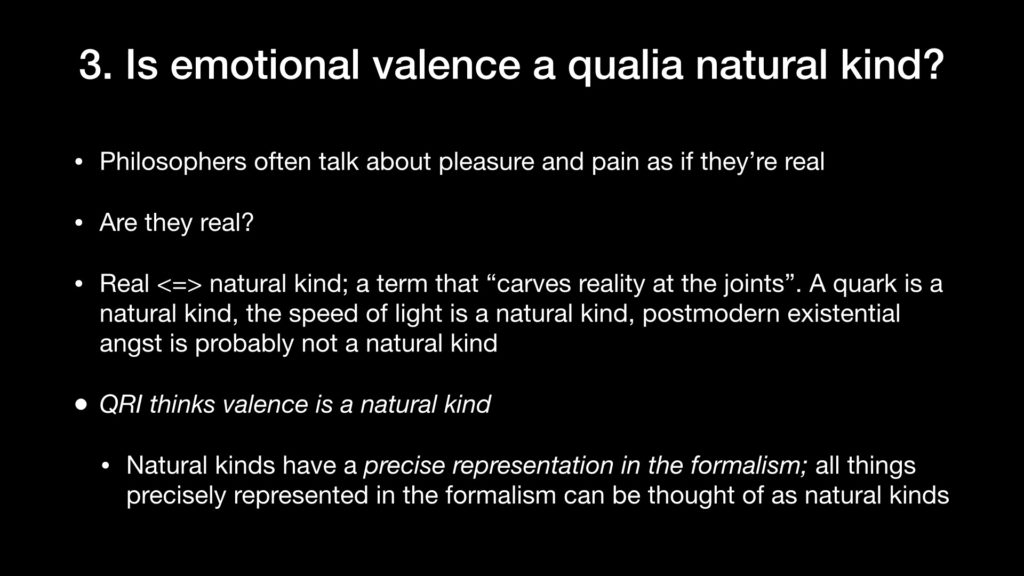
Part of the foundation of Principia Qualia was assuming that emotional valence is a natural kind, or at least it’s a very promising place to start looking. This is intuitive to some people, and not intuitive to others. I think the best metric here is “if we assume this, what next? What does this buy us?” — see (5).
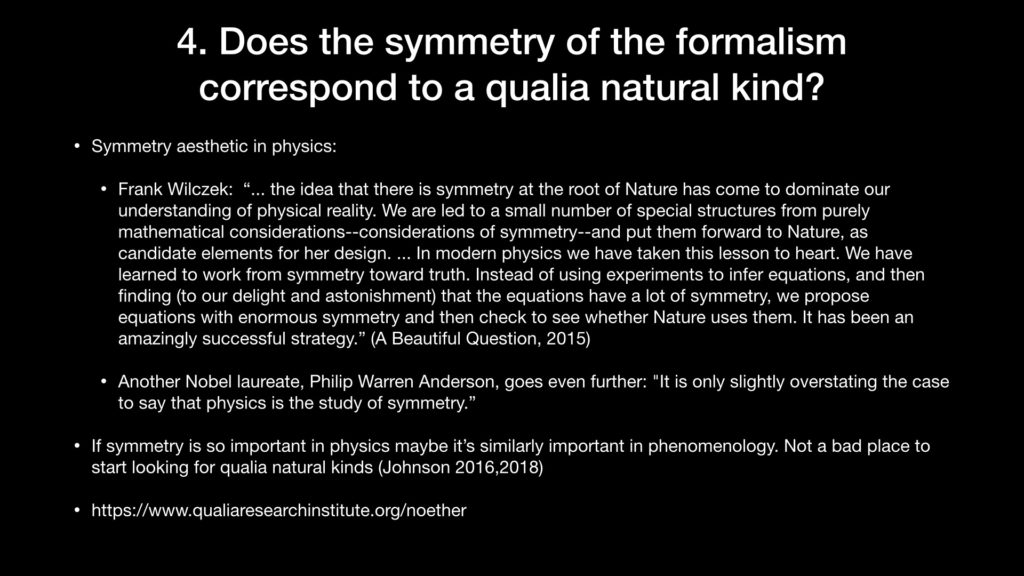
Symmetry plays a big role in physics, and in all mathematical formalisms. If there is a mathematical formalism for qualia, it would be surprising if symmetry doesn’t play a central role in it. See e.g. Emmy Noether and the symmetry aesthetic.
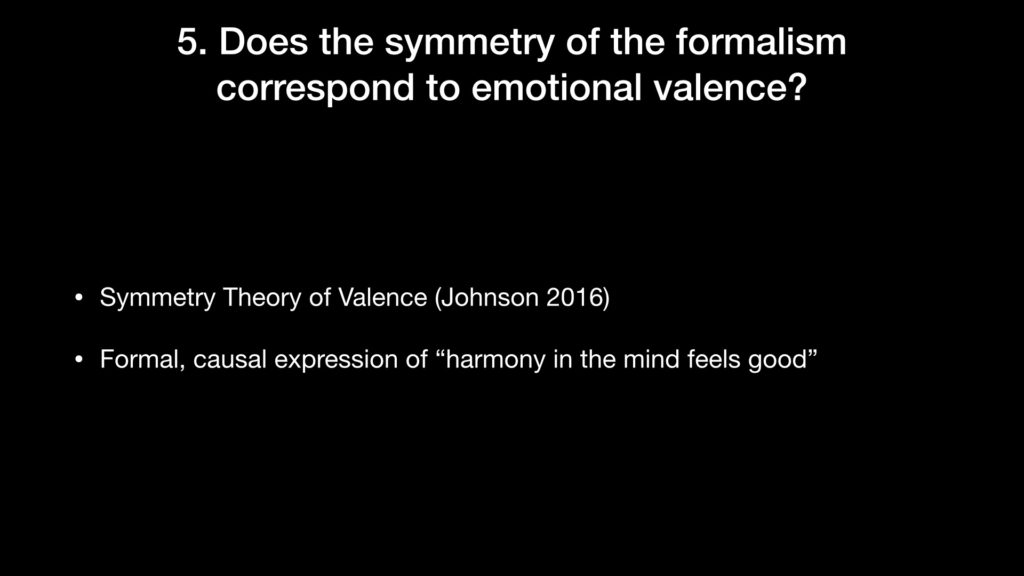
This is the big synthesis of PQ’s STV: formalism + emotional valence is a natural kind + symmetry of the formalism corresponds to emotional valence. I don’t know that it’s true, but it should be ultimately testable. A positive result would potentially buy us a lot, since it would resolve this question and all binary questions this question depends on. A negative result wouldn’t be particularly illuminating: “something’s wrong with one or more of your assumptions or the way you’re testing them.”
See PQ for the original argument, and the much shorter STV Primer for a condensed summary and updated testing protocol integrating Atasoy and Emilsson’s research.
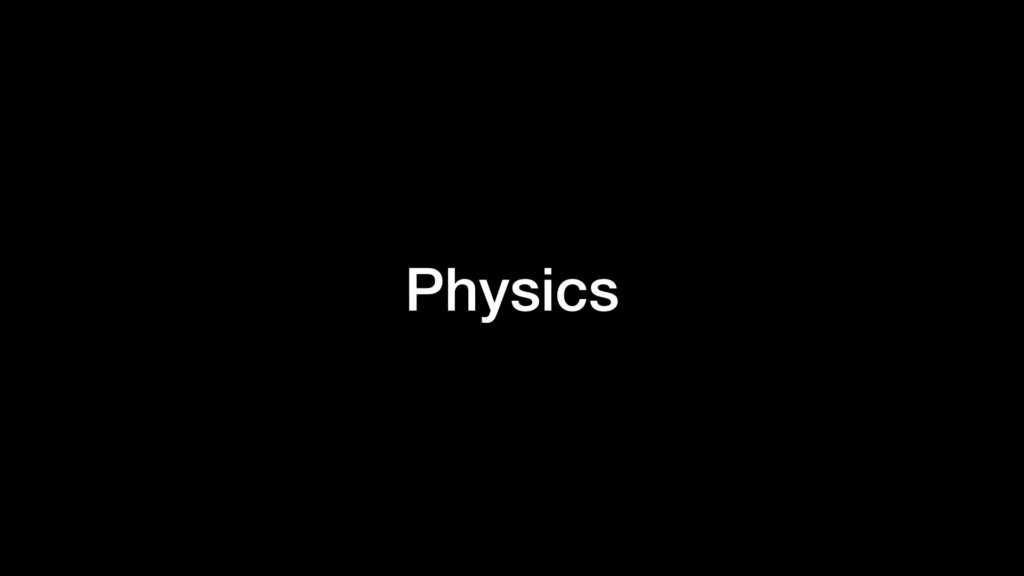
I think physics is a gold-mine for consciousness research. Many other scientists (ok to be honest — mostly physicists) seem to feel the same. But there’s some confusion about how to use physics, what to mine it for, what the goal should be in integrating these two domains. I’ve read a lot of papers on consciousness from physicists which are very mathematically impressive, but don’t “go all the way” to becoming works of phenomenology. Tegmark’s 2014 Consciousness as a state of matter is a great example here (and an absolute tour-de-force of mathematical prowess). My intuition is that physicists tend to try to collapse the analogical ambiguity too quickly, perhaps because they’re writing for other physicists who have physics-style norms for (immediate) rigor; instead of going straight for the precise mathematical space of consciousness, it may be better to gather as many high-level, formalism-agnostic principles, aesthetic intuitions, and heuristics as possible, to constrain and guide the explanation space (e.g. Noether), and only then strike at the formalism. To be more comfortable being playful and analogical and intuitive.

Heraclitus held that all of reality is built from different types of fire; Democritus said everything was atoms; Spinoza defined reality as dancing monads set in motion by God; Russell suggested neutral monism; David Pearce describes his view as “wavefunction monism … [t]he solutions to the equations of QFT or its generalization yield the values of qualia.”
I’m also on “team monism” and would suggest there’s a ’weak’ version and a ’strong’ version. I’m most bullish on the strong version: from Taking Monism Seriously, “[The] meta-theorem of monism [states that] every true theorem in physics will have a corresponding true theorem in phenomenology, and vice-versa. … Literally speaking— if we go through a textbook on physics and list the theorems, ultimately we’ll be able to find a corresponding truth in phenomenology for every single one. I don’t know of any ‘strong dual-aspect monists’ out there doing this— but there should be.”
If someone believes that consciousness arises from physical dynamics (i.e. atoms, not bits) and does not apply the lens of Strong monism, I think they’re leaving a huge amount of value on the table.
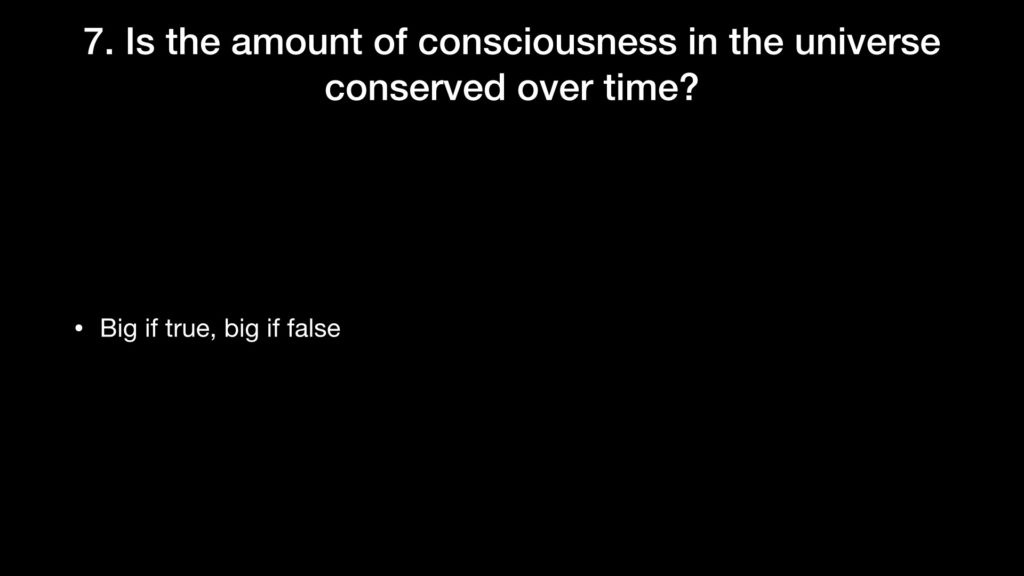
Perhaps the most important lens for understanding a physical system (such as a universe) is its conservation laws. The universe we live in conserves multiple physical properties. Which phenomenological conservation laws does our universe respect? With a nod to Emmy Noether, here’s Wikipedia with examples from physics:


This one I included more for fun than for cutting down the possibility space. But it is fun to consider. My tacit point here is a good theory of consciousness should be able to field these sorts of questions. (H/T Aaronson)
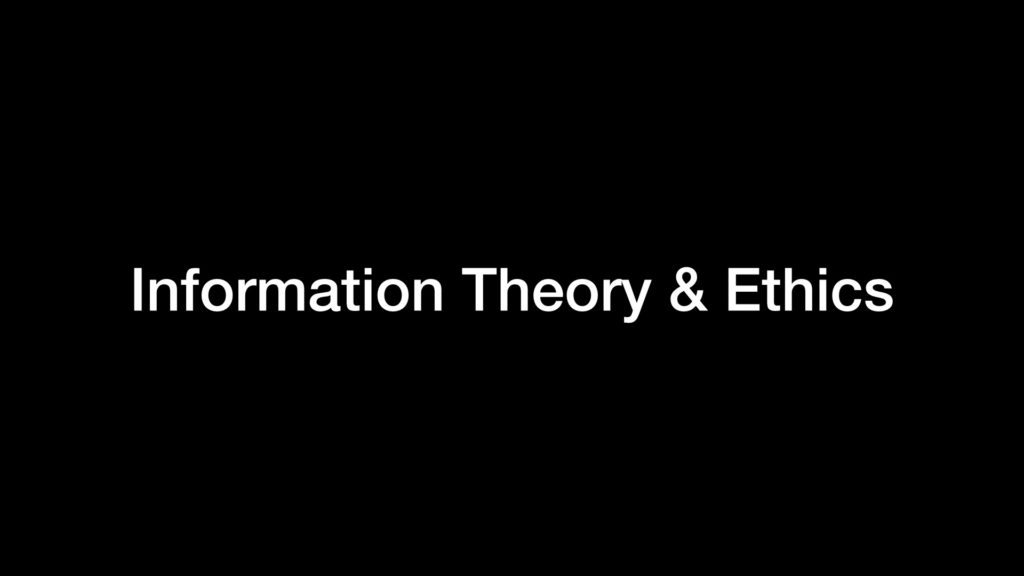
Futurists & philosophers like Nick Bostrom, Anders Sandberg, David Pearce, and Derek Parfit write about utopia and the best use of our ‘cosmic endowment’. Elon Musk notes his life-goal is to “preserve the light of consciousness”. Robin Hanson (grabby aliens), Anatoly Karlin (The Katechon Hypothesis), and Dan Faggella worry about the game theory of intelligent civilizations.
Kwame Appiah wrote that “in life, the challenge is not so much to figure out how best to play the game; the challenge is to figure out what game you’re playing.” Maybe consciousness research can help.
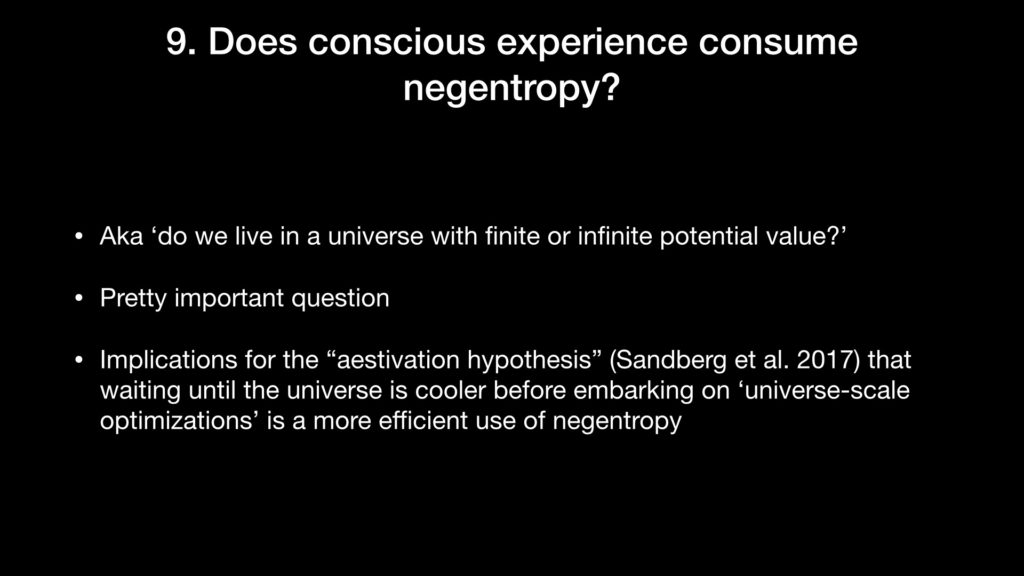
The total amount of entropy in the universe always increases: although local pockets of order can persist and grow, the universe as a whole always evolves from a more ordered state into a more disordered state. Doing ‘computationally useful work’ relies on there being a gradient of order and consumes this gradient — physicists sometimes call this finite resource ‘negative entropy’, or ‘negentropy’. At some point, the universe will run out of negentropy; it’ll be of uniform temperature and there will be no more pockets or gradients of order. Once this happens, no more work can be done. Our universe will be cold and lifeless forever more.
That’s the simple story. The slightly more complex story involves constructing the arrow of time through statistics and anthropics: perhaps time doesn’t objectively exist, but humans-as-observers experience time based on considerations around which partitionings of reality can support ordered lifelike processes. Or something like that.
The question I want to ask, though, is what is the ultimate fate of consciousness in a universe with finite negentropy? Does the production of qualia also necessarily use up finite negentropy? Even more specifically — does the production of ‘valuable’ qualia use up anything finite? Or is there infinite qualia in the universe’s future? The answer to question (7) will be very relevant here. See also: time crystals, Aaronson on subjective experience requiring ’full participation in the arrow of time’, Emilsson’s The Pseudo-Time Arrow.
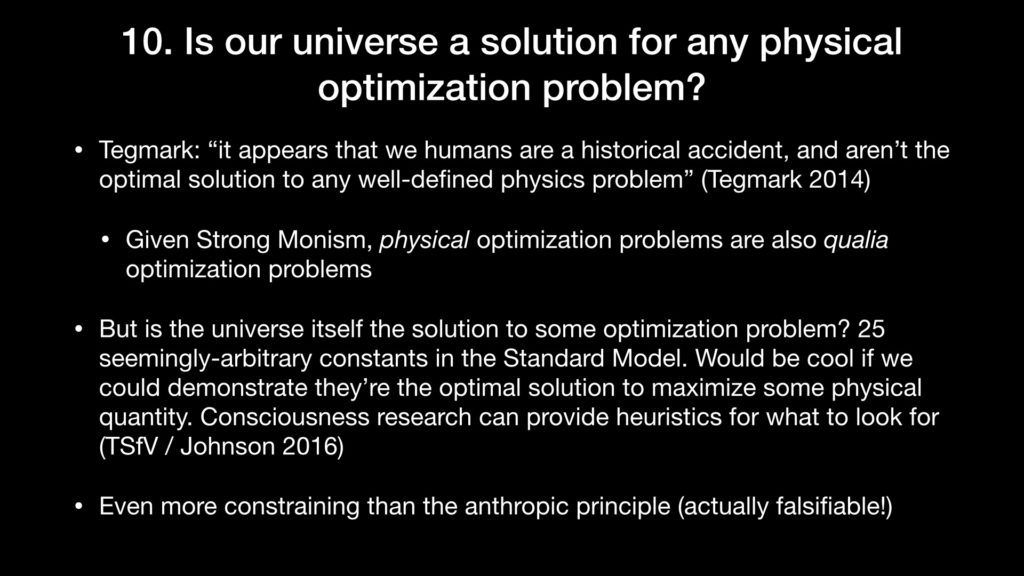
I stashed a very crazy idea in the final appendix of PQ. If it’s true it would offer a very strong answer to almost all of these questions. I don’t expect people to take it seriously for a few decades. See also: What’s Out There.
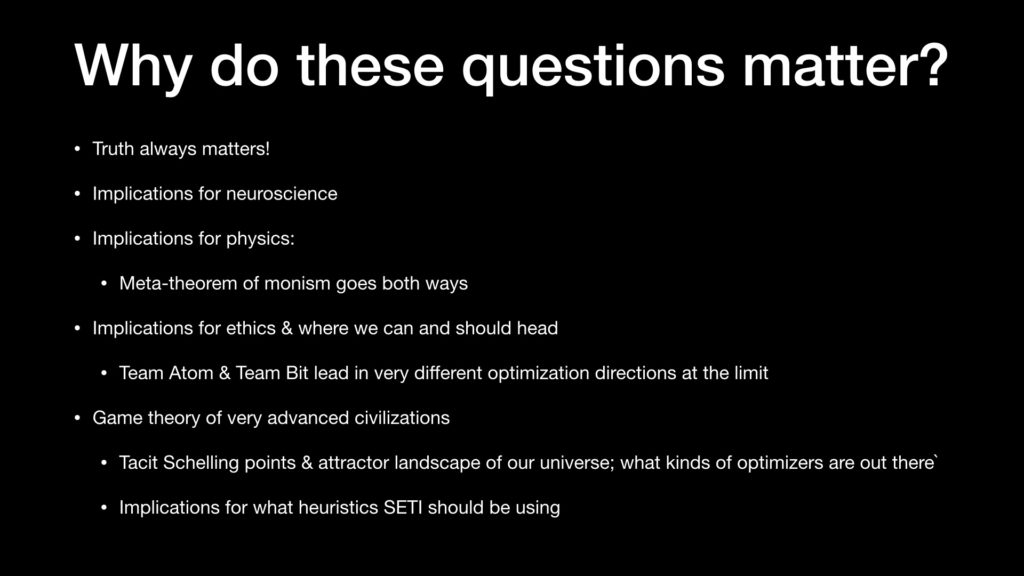
Finally — I could write extensively about why these questions matter. But if you’ve gotten this far, chances are you’re intrinsically curious about this stuff and I don’t need to ‘sell’.
Thank you for being curious!
I’m also grateful for the people who have dug under the surface and “really tried” to make progress on consciousness: all of QRI (especially Romeo & Andres); Giulio Tononi; Adam Safron; Max Tegmark; Johannes Kleiner; Adam Barrett; David Pearce; Scott Aaronson; Scott McCabe; and many I’m missing.
Addendum: having shamelessly stolen and adapted Wheeler’s “it from bit” phrase for this post, here’s a short excerpt from the beginning of his paper where he offers the original intention (which is related to but slightly different than mine).
John Archibald Wheeler
Abstract: This report reviews what quantum physics and information theory have to tell us about the age-old question, How come existence? No escape is evident from four conclusions: (1) The world cannot be a giant machine, ruled by any preestablished continuum physical law. (2) There is no such thing at the microscopic level as space or time or spacetime continuum. (3) The familiar probability function or functional, and wave equation or functional wave equation, of standard quantum theory provide mere continuum idealizations and by reason of this circumstance conceal the information-theoretic source from which they derive. (4) No element in the description of physics shows itself as closer to primordial than the elementary quantum phenomenon, that is, the elementary device-intermediated act of posing a yes-no physical question and eliciting an answer or, in brief, the elementary act of observer-participancy. Otherwise stated, every physical quantity, every it, derives its ultimate significance from bits, binary yes-or-no indications, a conclusion which we epitomize in the phrase, it from bit.
19.1 Quantum Physics Requires a New View of Reality
Revolution in outlook though Kepler, Newton, and Einstein brought us [1-4], and still more startling the story of life [5-7] that evolution forced upon an unwilling world, the ultimate shock to preconceived ideas lies ahead, be it a decade hence, a century or a millenium. The overarching principle of 20th-century physics, the quantum [8]— and the principle of complementarity [9]that is central idea of the quantum — leaves us no escape, Niels Bohr tells us, [10] from “a radical revision of our attitude as regards physical reality” and a “fundamental modification of all ideas regarding the absolute character of physical phenomena.” Transcending Einstein’s summons [11] of 1908, “This quantum business is so incredibly important and difficult that everyone should busy himself with it,” Bohr’s modest words direct us to the supreme goal: Deduce the quantum from an understanding of existence.
How make headway toward a goal so great against difficulties so large? The search for understanding presents to us three questions, four no’s and five clues:
Three questions,
• How come existence?
• How come the quantum?
• How come “one world” out of many observer-participants?
Four no’s,
• No tower of turtles
• No laws
• No continuum
• No space, no time.
Five clues,
• The boundary of a boundary is zero
• No question? No answer!
• The super-Copernican principle
• “Consciousness”
• More is different
19.2 “It from Bit” as Guide in Search for Link Connecting Physics, Quantum and Information
In default of a tentative idea or working hypothesis, these questions, no’s and clues — yet to be discussed — do not move us ahead. Nor will any abundance of clues assist a detective who is unwilling to theorize how the crime was committed! A wrong theory? The policy of the engine inventor, John Kris, reassures us, “Start her up and see why she don’t go!” In this spirit [12-47] I, like other searchers [48-51] attempt formulation after formulation of the central issues, and here present a wider overview, taking for workinghypothesis the most effective one that has survived this winnowing: It from bit. Otherwise put, every it — every particle, every field of force, even the spacetime continuum itself — derives its function, its meaning, its very existence entirely — even if in some contexts indirectly — from the apparatus- elicited answers to yes or no questions, binary choices [52], bits.
It from bit symbolizes the idea that every item of the physical world has at bottom — at a very deep bottom, in most instances — an immaterial source and explanation; that what we call reality arises in the last analysis from the posing of yes-no questions and the registering of equipment-evoked responses; in short, that all things physical are information-theoretic in origin and this is a participatory universe.
Three examples may illustrate the theme of it from bit. First, the photon. With polarizer over the distant source and analyzer of polarization over the photodetector under watch, we ask the yes or no question, “Did the counter register a click during the specified second?” If yes, we often say, “A photon did it.” We know perfectly well that the photon existed neither before the emission nor after the detection. However, we also have to recognize that any talk of the photon “existing” during the intermediate period is only a blown-up version of the raw fact, a count.
The yes or no that is recorded constitutes an unsplitable bit of information. A photon, Wootters and Zurek demonstrate [53, 54], cannot be cloned.